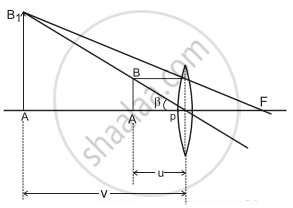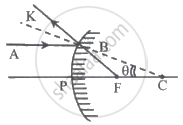Advertisements
Advertisements
प्रश्न
Answer the following question in detail.
Derive an expression for the magnifying power of a simple microscope. Obtain its minimum and maximum values in terms of its focal length.
उत्तर
- Figure (a) shows the visual angle α made by an object when kept at the least distance of distinct vision (D = 25 cm). Without an optical instrument, this is the greatest possible visual angle as we cannot get the object closer than this.

(a) Visual Angle α
(b) Visual Angle β - Figure (b) shows a convex lens forming an erect, virtual, and magnified image of the same object when placed within the focus.
- The visual angle β of the object and the image, in this case, is the same. However, this time the viewer is looking at the image which is not closer than D. Hence the same object is now at a distance smaller than D.
- Angular magnification or magnifying power, in this case, is given by
M = `"Visual angle of the image"/"Visual angle of the object at D"=β/α`
For small angles
M = `β/α≈(tan(β))/(tan(α))=("BA/PA")/"BA/D"="D"/"u"` - For maximum magnifying power, the image should be at D. For a thin lens, considering thin lens formula, `1/"f"=1/"v"-1/"u"`
In case of simple microscope,
f = +f, v = – D, u = – u and M = Mmax
∴ `1/"f"=1/-"D"-1/-"u"`
∴ `"D"/"f"="D"/-"D"+"D"/"u"`
As, M = `"D"/"u"`,
Mmax = `1+"D"/"f"` - For minimum magnifying power, v = ∞ and u = f (numerically)
∴ Mmin = `"D"/"u"="D"/"f"`
APPEARS IN
संबंधित प्रश्न
Answer the following question in detail.
Define and describe the magnifying power of an optical instrument.
Answer the following question in detail.
What is a terrestrial telescope and an astronomical telescope?
Answer the following question in detail.
Obtain the expressions for magnifying power and the length of an astronomical telescope under normal adjustments.
Answer the following question in detail.
What is the limitation in increasing the magnifying powers of a simple microscope?
Discuss about simple microscope and obtain the equations for magnification for near point focusing and normal focusing.
Why is oil-immersed objective preferred in a microscope?
What are the advantages and disadvantages of using a reflecting telescope?
What are the uses of spectrometer?
What is the remedy of myopia?
What is hypermetropia?
What is astigmatism? What is its remedy?
Discuss about simple microscope and obtain the equations for magnification for near point focusing and normal focusing.
Mention different parts of the spectrometer.
Explain the preliminary adjustments of the spectrometer.
Explain the experimental determination of the material of the prism using a spectrometer.
The near point and the far point for a person are 50 cm and 500 cm, respectively. Calculate the power of the lens the person should wear to read a book held in hand at 25 cm. What maximum distance is clearly visible for the person with this lens on the eye?
There are four convex lenses L1, L2, L3 and L4 of focal length 2, 4, 6 and 8 cm, respectively. Two of these lenses from a telescope of length 10 cm and magnifying power 4. The objective and eye lenses are respectively
A simple microscope is used to see the object first in blue light and then in red light. Due to the change from blue to red light, what is the effect on its magnifying power?
The speed of light in media 'A' and 'B' are 2.0 × 1010 cm/s and 1.5 × 1010 cm/s respectively. A ray of light enters from medium B to A at an incident angle 'θ'. If the ray suffers total internal reflection, then ______.
An object viewed from a near point distance of 25 cm, using a microscopic lens with magnification '6', gives an unresolved image. A resolved image is observed at infinite distance with a total magnification double the earlier using an eyepiece along with the given lens and a tube of length 0.6 m, if the focal length of the eyepiece is equal to ______ cm.
Magnification produced by astronomical telescope for normal adjustment is 10 and length of telescope is 1.1 m. The magnification when the image is formed at least distance of distinct vision (D = 25 cm) is ______.
An observer looks at a distant tree of height 10 m with a telescope of magnifying power of 20. To the observer the tree appears:
In the adjoining figure, AB represents the incident ray, and BK is the reflected ray. If angle BCF = θ, then ∠BFP is given by ______.

A camera objective has an aperture diameter of d. If the aperture is reduced to diameter d/2, the exposure time under identical conditions of light should be made ______.
